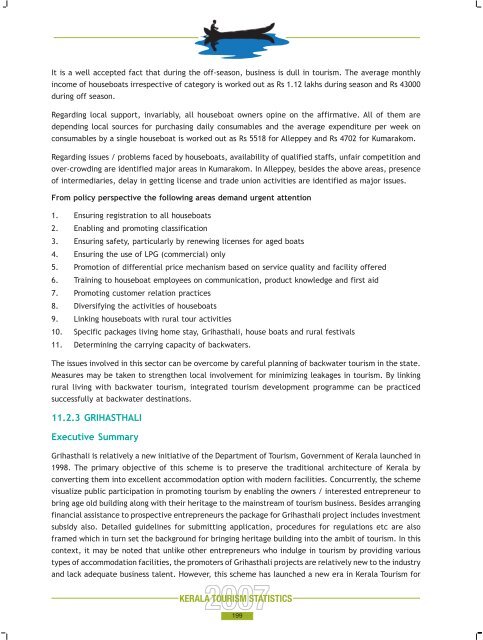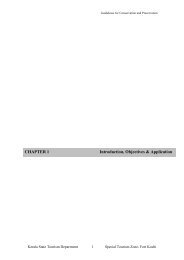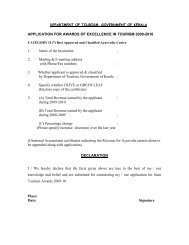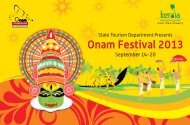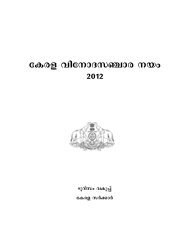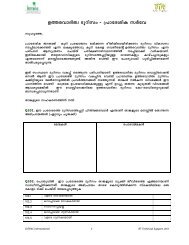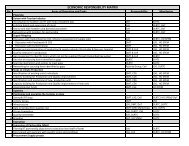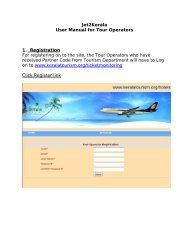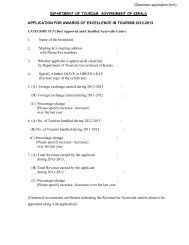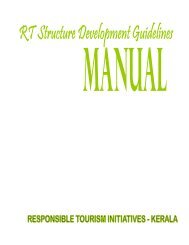Statistics Book 2007.pdf - Kerala Tourism
Statistics Book 2007.pdf - Kerala Tourism
Statistics Book 2007.pdf - Kerala Tourism
Create successful ePaper yourself
Turn your PDF publications into a flip-book with our unique Google optimized e-Paper software.
It is a well accepted fact that during the off-season, business is dull in tourism. The average monthly<br />
income of houseboats irrespective of category is worked out as Rs 1.12 lakhs during season and Rs 43000<br />
during off season.<br />
Regarding local support, invariably, all houseboat owners opine on the affirmative. All of them are<br />
depending local sources for purchasing daily consumables and the average expenditure per week on<br />
consumables by a single houseboat is worked out as Rs 5518 for Alleppey and Rs 4702 for Kumarakom.<br />
Regarding issues / problems faced by houseboats, availability of qualified staffs, unfair competition and<br />
over-crowding are identified major areas in Kumarakom. In Alleppey, besides the above areas, presence<br />
of intermediaries, delay in getting license and trade union activities are identified as major issues.<br />
From policy perspective the following areas demand urgent attention<br />
1. Ensuring registration to all houseboats<br />
2. Enabling and promoting classification<br />
3. Ensuring safety, particularly by renewing licenses for aged boats<br />
4. Ensuring the use of LPG (commercial) only<br />
5. Promotion of differential price mechanism based on service quality and facility offered<br />
6. Training to houseboat employees on communication, product knowledge and first aid<br />
7. Promoting customer relation practices<br />
8. Diversifying the activities of houseboats<br />
9. Linking houseboats with rural tour activities<br />
10. Specific packages living home stay, Grihasthali, house boats and rural festivals<br />
11. Determining the carrying capacity of backwaters.<br />
The issues involved in this sector can be overcome by careful planning of backwater tourism in the state.<br />
Measures may be taken to strengthen local involvement for minimizing leakages in tourism. By linking<br />
rural living with backwater tourism, integrated tourism development programme can be practiced<br />
successfully at backwater destinations.<br />
11.2.3 GRIHASTHALI<br />
Executive Summary<br />
Grihasthali is relatively a new initiative of the Department of <strong>Tourism</strong>, Government of <strong>Kerala</strong> launched in<br />
1998. The primary objective of this scheme is to preserve the traditional architecture of <strong>Kerala</strong> by<br />
converting them into excellent accommodation option with modern facilities. Concurrently, the scheme<br />
visualize public participation in promoting tourism by enabling the owners / interested entrepreneur to<br />
bring age old building along with their heritage to the mainstream of tourism business. Besides arranging<br />
financial assistance to prospective entrepreneurs the package for Grihasthali project includes investment<br />
subsidy also. Detailed guidelines for submitting application, procedures for regulations etc are also<br />
framed which in turn set the background for bringing heritage building into the ambit of tourism. In this<br />
context, it may be noted that unlike other entrepreneurs who indulge in tourism by providing various<br />
types of accommodation facilities, the promoters of Grihasthali projects are relatively new to the industry<br />
and lack adequate business talent. However, this scheme has launched a new era in <strong>Kerala</strong> <strong>Tourism</strong> for<br />
199


